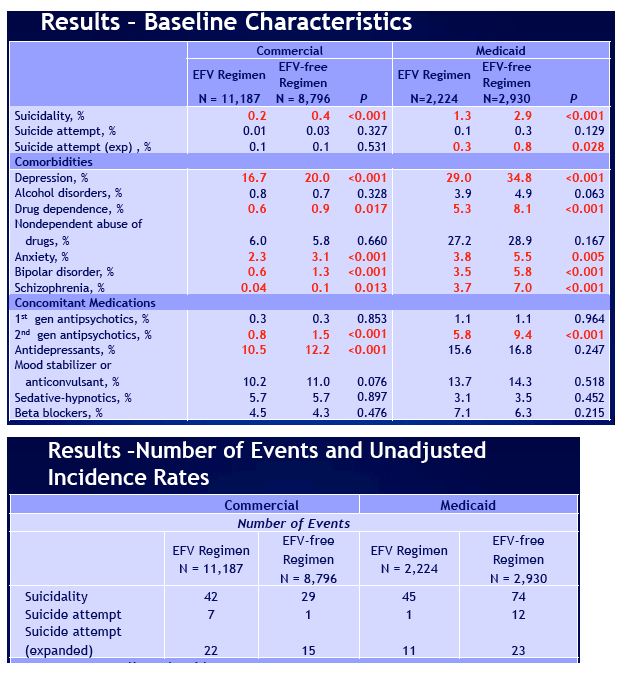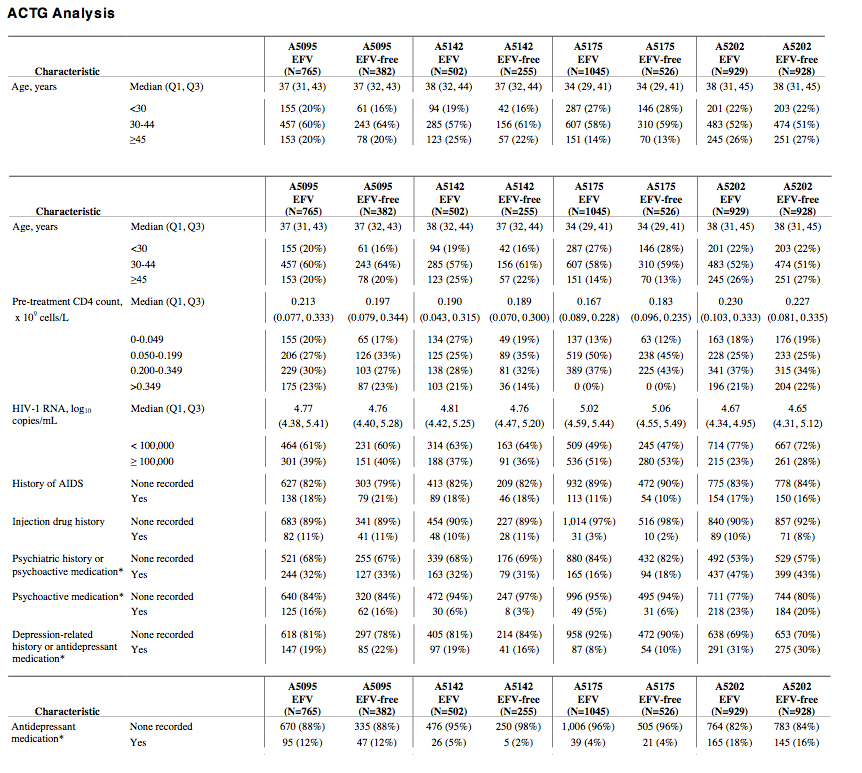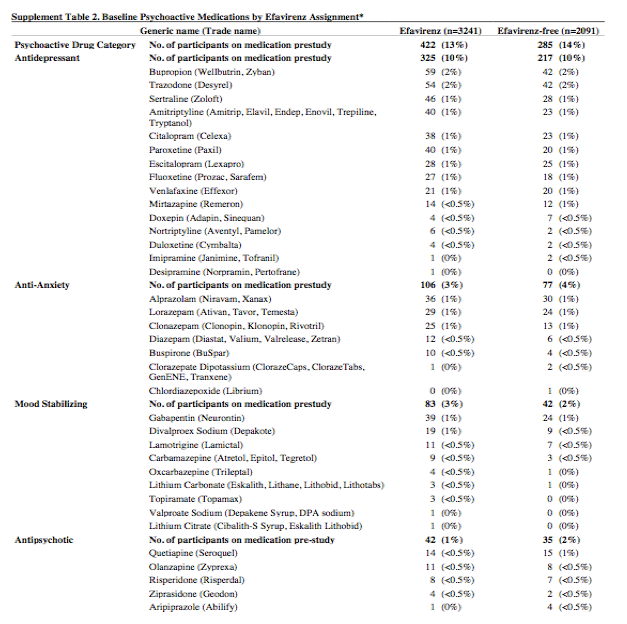 |
 |
 |
| |
Efavirenz & Suicidality....New analysis among Medicaid & Commercial databases finds no association, reflects current EFV use patterns & safer/proper use of EFV.......
|
| |
| |
Jules Levin, NATAP
here is a study, 2 reports of the same study immediately below just presented at IDSA which does NOT find EFV associated with suicidality (an analysis of Medicaid/Commercial insurance databases), a different outcome compared to the ACTG study linked to below which found EFV associated with suicide ideation which was published this past July in Annals of Internal Medicine. In reviewing the 2 studies I found differences between the 2 studies and differences between the patient groups in the 2 different studies (ACTG vs medicaid/commercial insurance databases). The recent analysis by BMS presented at IDSA used medicaid & commercial insurance databases while the earlier published study was a meta-anslysis of several ACTG Studies by the ACTG. The ACTG analysis looked at studies started in 2001(to 2010) which is earlier than the studies considered in the BMS analysis which began in 2006 (to 2013). This suggests that the ACTG analysis included a different patient population, one that included patients with risk factors that we learned from these early studies that perhaps should not receive EFV, like IDUs or individuals at risk for or with a history of psychiatric conditions including suicide ideation, so if you look at the Baseline Patient Characteristics (see tables below) in the analysis just presented at IDSA in the 2nd link immediately below you will see patients receiving EFV were less likely to have certain psychiatric conditions compared to patients who did not receive EFV including depression, drug dependence, anxiety, bipolar disorder, schizophrenia, use of antipsychotropics & anti-depressants; and this medicaid/commercial insurance analysis obviously is not a randomized controlled study as the ACTG studies were. Injection drug use appears perhaps higher in the ACTG studies: 8-11% in ¾ studies and 2-3% in 1 study; in the recent IDSA analysis they refer to "drug dependence" and in the Medicaid population 5.3% receiving EFV & 8.1% receiving EFV-free regimen had "drug dependence", while in the Commercial database the rates were much lower: 0.6% & 0.9% respectively. In order to look at the Baseline Patient Characteristics in the ACTG analysis click the 3rd link below (or you can also see tables inserted in this email below) and then that will take you to the study report on the NATAP website where you will find the entire published study & the 2 pdfs one of which is the appendices which contains the Baseline Characteristics & the other the study itself. So this suggests I think the pattern, a different pattern, of which patients receive EFV more currently, that we learned from the early experiences reflected in those earlier ACTG studies who can safely use EFV & who EFV use is more risky. So the new analysis reflects the new improved use of EFV, better selection of who should use EFV. The data from the current/new analysis suggests if used properly, prescribed to correct patients EFV is not associated with any higher rate of suicidality vs EFV-free regimens. In fact in looking at table below you recent analysis saw a lower rate of suicidality for EFV compared to EFV-free regimens. And as you can see in table below those receiving EFV had lower rates in general of depression, lower rates of receiving antipsychotic medications and antidepressants in the Commercial population although the same in the Medicaid population, while in the ACTG study there appears to be no difference of the rates for receiving psychoactive medications between EFV or EFV-free regimens, although the 2nd largest ACTG study A5202 reported 23% on EFV & 20% on EFV-free regimens were receiving anti-psycohtic medications, it does not say if this difference is statistically different.
I think you will find interesting information if you compare the rates of depression, anti-depressant medications, look at the rates of antipsychotics.
Regarding suicidality:
- rates among medicaid population in more recent analysis are 1.3% among EFV users vs 2.9% among EFV-free regimens.
- event rates in Supplemental Table 4 for ACTG randomized study, restricted to USA, were among the 4 studies in the Intent-to-Treat analysis 14/765 in ACTG5095, 8/490 in ACTG5142, 6/140 in ACTG5175 & 20/929 in ACTG5202. It's hard to compare across studies & we are always warned not to, but the rates of use of "Psychoactive medication" in the older ACTG analysis ranging across all 4 studies are 5-6% to 16-20/23%, this compares to the rates of use of "2nd gen antipsychotics" in the recent analysis in the medicaid population of 5.8% in those receiving EFV to 9.4% in those not receiving EFV.
In the ACTG analysis they say: "In multivariable analyses, factors associated with increased hazard of suicidality were random assignment to efavirenz, self-reported history of IDU, and documented psychiatric history or recent prestudy psychoactive medication.....This study has limitations. Three of 4 trials were open-label and thus suicidality, particularly suicidal ideation, may have been susceptible to reporting bias; suicide was listed under postmarketing experiences in the efavirenz prescribing information before the time frame of these studies (5). There was no standardized questionnaire about suicidality or depression, such as the Hamilton scale (39), and psychiatric or suicidal history may have been underreported or undisclosed to care providers. Further, patients with psychiatric history could have been selectively not referred or recruited to these clinical trials because of concerns for potential adverse events."
DEPRESSION Rates: of interest both analyses reported pretty high rates of depression among all patients. In the recent analysis 16-20% among EFV & EFV-free regimens in Commercial insurance group and 29-34% in the medicaid group & of note less depression among those who recd EFV 16.7% vs 20.0% in the Commercial ins group & in the Medicaid group 29.0% in those receiving EFV vs 34.8% in those receiving EFV-free regimen. Critics suggest Medicaid & Commercial insurance databases may not be able to accurately capture suicidality or suicide attempts. The suicide attempt rate is 0.8% in the EFV-free regimens group in the Medicaid population so 0.8% of 2,930 is 234; the average age in this group is 39.7 (11.6) so we don't know how this compares with the rate among the general population, is it higher among HIV+, my suspicion is yes. The suicide attempt rate was lower in the Commercial insurance group: 0.1% in both the EFV regimen & EFV-free regimen groups.
IDSA: Commercial and Medicaid Claims Databases Show No Evidence of Higher Suicidality With Efavirenz - Mark Mascolini - (10/15/14)
IDSA: Using Real World Data to Assess the Risk of Suicidality among Patients Initiating an Efavirenz versus an Efavirenz-Free Antiretroviral Regimen
Association Between Efavirenz as Initial Therapy for HIV-1 Infection and Increased Risk for Suicidal Ideation or Attempted or Completed Suicide: An Analysis of Trial Data..... http://www.natap.org/2014/HIV/071414_10.htm
ID Week
Oct 8-12 2014
Philadelphia
IDSA Analysis




|
| |
|
 |
 |
|
|